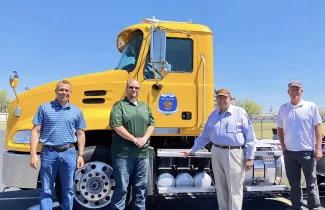
Deer hunters will have more opportunities to harvest antlerless deer this fall, and waterfowlers will have more hunting days in the middle of the season, after the Oklahoma Wildlife Conservation Commission approved two resolutions in its regular meeting May 4.
The Commission’s first-ever virtual meeting, to comply with social distancing guidelines related to the COVID-19 pandemic, was held via videoconference and streamed for public viewing on the Internet.
With antlerless deer harvest trending downward the past few years, biologists with the Oklahoma Department of Wildlife Conservation who manage the state’s deer herd urged more liberal bag limits and more open days for antlerless harvest, as specified in the approved resolution.
While muzzleloader and rifle season antlerless bag limits will increase in most zones, the total combined deer bag limit for each hunter will not change. All deer taken during muzzleloader and rifle seasons count toward a hunter’s combined season limit of six deer. Antlered deer limits remain unchanged.
Chief of Wildlife Bill Dinkines told Commissioners that antlerless harvest as a percentage of total deer harvest has decreased from 42 percent in 2014 to 36 percent in 2018.
The new regulations affect antlerless harvest in all 10 of the state’s antlerless deer management zones. Additionally, the holiday antlerless deer season will increase from 10 to 14 days with the bag limit increasing to two, which are considered bonus deer and do not count toward a hunter’s regular season limit of six deer.
To promote antlerless deer harvest, a public information campaign will begin, said Nels Rodefeld, Chief of Information and Education for the Department. It will be similar to the successful “Hunters in the Know … Take a Doe!” campaign from 2001-06. The Department will also look into other ways to increase antlerless deer harvest.
Waterfowl seasons will be different this year. The midseason split will be reduced from 12 days to five days, which will allow opening day to fall later on the calendar than usual. Also, Zones 1 and 2 will have the same dates: Nov. 14-29, and Dec. 5-Jan. 31, 2021. Two youth-only hunting days will occur Nov. 7 and Feb. 6, 2021, but now will also welcome active and veteran military members to hunt those days.
Also during Monday’s meeting, Commissioners accepted two large donations. Quail Forever chapters in Oklahoma donated a total of $10,172.50 to fund habitat improvement equipment and activities at several Wildlife Management Areas. Laura McIver, QF regional representative, told Commissioners these donations, when coupled with matching federal funds, will provide more than $44,000 for wildlife habitat work to benefit quail and other wildlife.
Barry Bolton, Chief of Fisheries, recognized Groendyke Transport Inc. and its chief executive, outgoing Commissioner John D. Groendyke of Enid, for donating a 2013 Mack Trucks semi-tractor to replace one the Department has used for 22 years. Northwest Region Fisheries Supervisor Chas Patterson thanked Groendyke for the generous donation and said the tractor will be invaluable in moving heavy equipment throughout his region and the state.
Donations from conservation partners such as Quail Forever and from concerned individuals are invaluable in helping the Department manage and protect fish and wildlife, along with habitat, while growing our community of hunters and anglers, partnering with those who love the outdoors, and fostering stewardship with those who care for the land.
The Wildlife Department doesn’t receive any general state tax appropriations. License sales and federal grant revenues are the main funding sources. Every license dollar spent by sportsmen in Oklahoma is used to fund ODWC's user-pay/public-benefit conservation efforts.
In other business, Commissioners:
- Heard Director J.D. Strong’s regular report on Department activities. He said hunting and fishing license sales are holding steady overall since the COVID-19 outbreak.
- Approved hiring a full-time coordinator for boating access and shooting range projects, which will take advantage of increased federal funding available for those purposes.
To view a recording of the meeting, go to https://youtu.be/1VnEjVBmsuM.
The Oklahoma Wildlife Conservation Commission is the eight-member governing board of the Oklahoma Department of Wildlife Conservation. The Commission establishes state hunting and fishing regulations, sets policy for the Wildlife Department and indirectly oversees all state fish and wildlife conservation activities. Commission members are appointed by the governor and confirmed by the Oklahoma Senate.
The next scheduled Commission meeting is set for 9 a.m. Monday, June 1, 2020, at Wildlife Department headquarters, 1801 N. Lincoln Blvd., Oklahoma City.